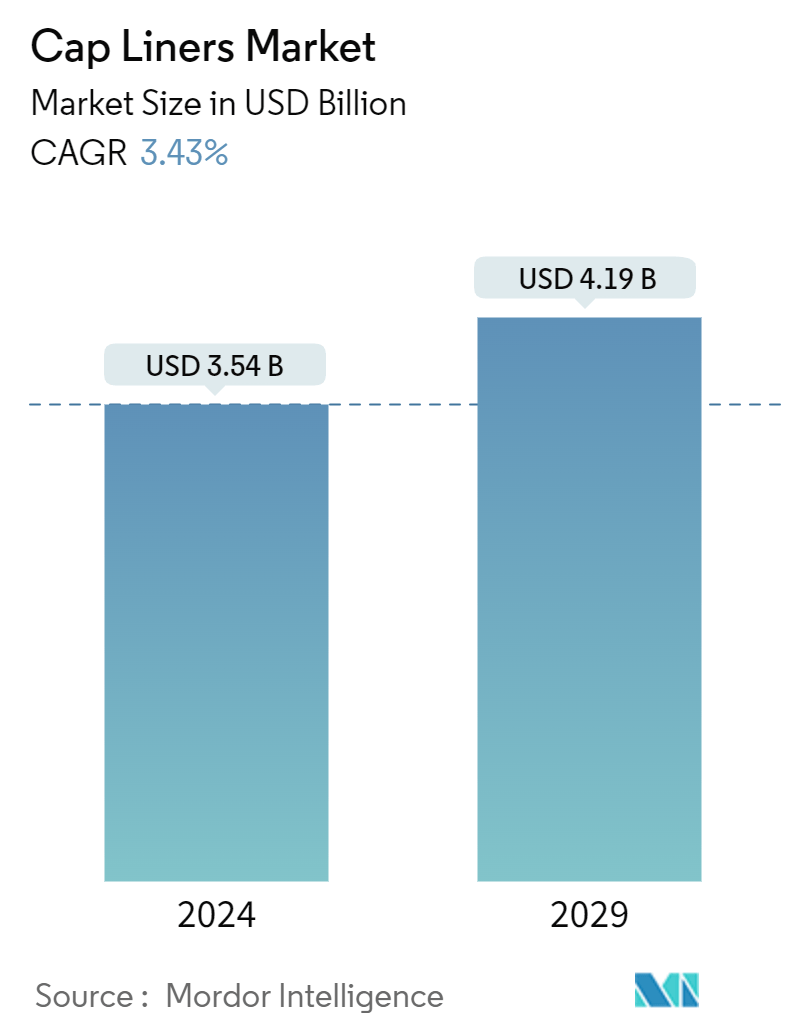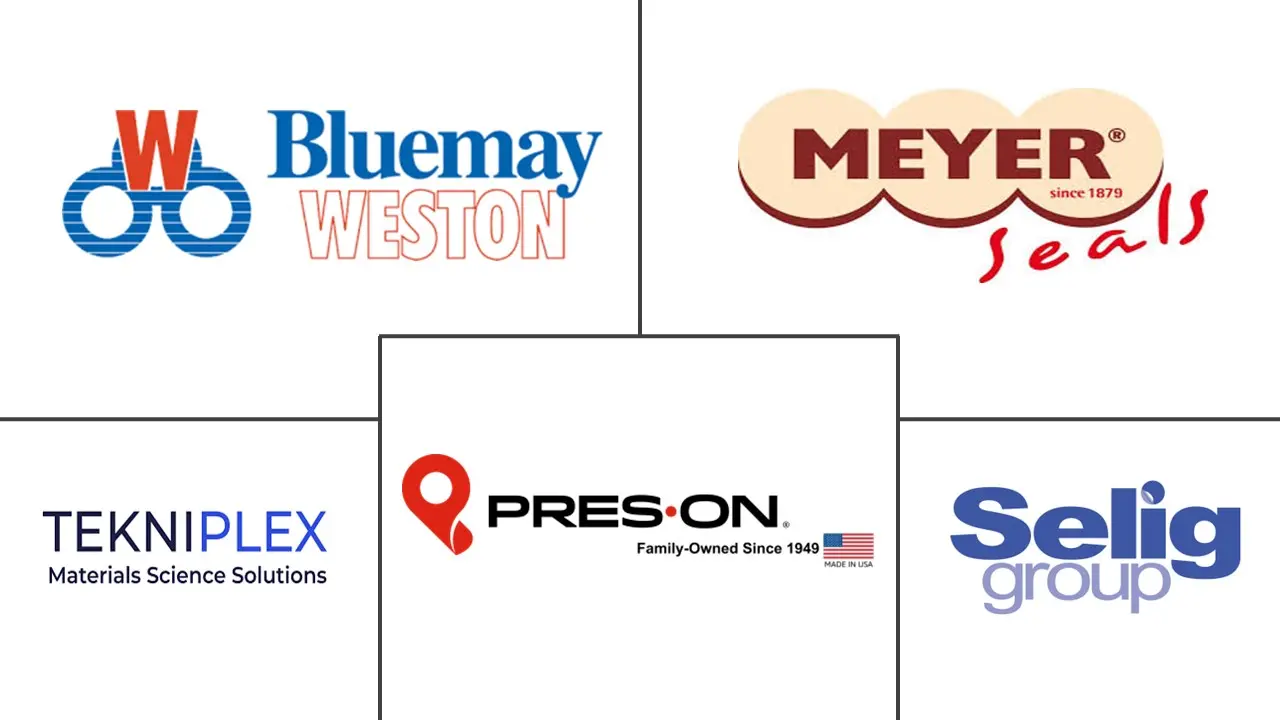Market Size of Cap Liners Industry

| Study Period | 2019 - 2029 |
| Market Size (2024) | USD 3.54 Billion |
| Market Size (2029) | USD 4.19 Billion |
| CAGR (2024 - 2029) | 3.43 % |
| Fastest Growing Market | North America |
| Largest Market | Asia Pacific |
| Market Concentration | Low |
Major Players
*Disclaimer: Major Players sorted in no particular order |
Cap Liners Market Analysis
The Cap Liners Market size is estimated at USD 3.54 billion in 2024, and is expected to reach USD 4.19 billion by 2029, growing at a CAGR of 3.43% during the forecast period (2024-2029).
The demand for cap liners in the packaging industry is poised to surge as the industry pushes its boundaries. Cap liners are gaining unprecedented importance in multiple end-user industries, such as food, beverage, and pharmaceuticals, driven by the growing reliance of the affluent population.
Cap liners' ability to establish tamper evidence propels their demand to new heights. A wide array of cap liners, including essential, pressure-sensitive, and heat induction, is revolutionizing the packaging industry.
Businesses are increasingly turning to sustainable materials to shrink their carbon footprints. Adopting vented induction cap liners to tackle the high-altitude bottle collapsing issue is particularly promising for product manufacturers. Industries increasingly rely on these liners to enhance the sealing, branding, and shelf appeal of their packaged product.
According to Integrated Liner Technologies, the prevalent cap liner types include silicone, butyl rubber, PTFE, polyethylene, and foil. Each offers distinct advantages tailored to different end-user industry needs, with the selection process hinging on factors like content chemistry, temperature sensitivity, and external vulnerability. These considerations aim to ensure chemical resistance, flexibility, cushioning, and regulatory compliance, all pivotal for upholding quality and safety standards.
Moreover, heightened consumer awareness of food safety and sustainability is driving the adoption of innovative cap liner materials and designs. Also, pharmaceutical companies select cap liners based on their compatibility with the contents and ability to maintain seal integrity, which is crucial for safeguarding samples in storage.
The market might also face challenges, such as poor cap-liner contact, leading to inadequate sealing, leaks, and spills. Excessive heating of induction cap liners compromises packaging quality and challenges the market. However, using plastic or polyester liners is a letdown for eco-conscious businesses, hindering the wider adoption of cap liners.
Cap Liners Industry Segmentation
In recent years, cap liners have emerged as pivotal elements in container packaging. The cap liner market has witnessed substantial growth, propelled mainly by the rising demand from various end-user industries driven by the convenience sought by urban consumers for on-the-go consumption.
The cap liners market is segmented by material type (rubber, metal, plastic, and paper), application (bottles and jars & containers), product type (heat-induction cap liners [one-piece, two-piece, Halfmoon liner, and other heat-induction cap liners], pressure sensitive liners, and other product types), end-user industry (food, beverage, personal care & cosmetics, chemicals & fertilizers, oil, lubricants, and grease, home care, and other end-user industries), by geography (North America [United States and Canada], Europe [France, Germany, Turkey, Spain, United Kingdom, and Rest of Europe], Asia-Pacific [China, India, Japan, Thailand, Australia and New Zealand, and Rest of Asia-Pacific], Latin America [Brazil, Mexico, and Rest of Latin America], Middle East and Africa [United Arab Emirates, Saudi Arabia, Egypt, South Africa, and Rest of Middle East and Africa]). The report offers market forecasts and size in value (USD) for all the abovementioned segments.
| By Material Type | |
| Rubber | |
| Metal | |
| Plastic | |
| Paper |
| By Application | |
| Bottles | |
| Jars & Containers |
| By Product Type | ||||||
| ||||||
| Pressure Sensitive Liners | ||||||
| Other Product Types |
| By End-user Industry | |
| Food | |
| Beverage | |
| Personal Care & Cosmetics | |
| Chemicals & Fertilizers | |
| Oil, Lubricants, and Grease | |
| Home Care | |
| Other End-user Industries |
| By Geography*** | |||||||
| |||||||
| |||||||
| |||||||
| |||||||
|
Cap Liners Market Size Summary
The cap liners market is experiencing significant growth, driven by increasing demand across various sectors such as food, beverage, and pharmaceuticals. These liners are crucial for ensuring tamper evidence, enhancing sealing, and improving the branding and shelf appeal of packaged products. The shift towards sustainable materials is also influencing market dynamics, with businesses adopting vented induction cap liners to address specific challenges like high-altitude bottle collapsing. The market is characterized by a diverse range of cap liner types, including silicone, butyl rubber, PTFE, polyethylene, and foil, each offering unique advantages tailored to the needs of different industries. The selection of cap liners is influenced by factors such as content chemistry, temperature sensitivity, and external vulnerability, ensuring compliance with quality and safety standards.
The pharmaceutical industry, in particular, is a significant driver of market growth due to its stringent packaging requirements and the rising demand for pharmaceutical products. Induction cap sealers play a vital role in securing over-the-counter prescription pills, tablets, and liquids, providing tamper-evident solutions that prevent leaks and preserve product freshness. The market is also witnessing increased demand for packaged beverages, with bottled water and non-alcoholic beverages gaining popularity, especially in regions like the United States. The cap liners market is fragmented, with key players focusing on strategic expansions through acquisitions and collaborations. Recent innovations, such as Tekni-Plex's recyclable paper-based induction heat seal liners, highlight the industry's commitment to sustainability and product protection.
Cap Liners Market Size - Table of Contents
-
1. MARKET INSIGHTS
-
1.1 Market Overview
-
1.2 Industry Attractiveness - Porter's Five Forces' Analysis
-
1.2.1 Bargaining Power of Suppliers
-
1.2.2 Bargaining Power of Buyers
-
1.2.3 Threat of New Entrants
-
1.2.4 Threat of Substitutes
-
1.2.5 Intensity of Competitive Rivalry
-
-
1.3 Industry Value Chain Analysis
-
-
2. MARKET SEGMENTATION
-
2.1 By Material Type
-
2.1.1 Rubber
-
2.1.2 Metal
-
2.1.3 Plastic
-
2.1.4 Paper
-
-
2.2 By Application
-
2.2.1 Bottles
-
2.2.2 Jars & Containers
-
-
2.3 By Product Type
-
2.3.1 Heat-induction Cap Liners
-
2.3.1.1 One-piece
-
2.3.1.2 Two-piece
-
2.3.1.3 Halfmoon Liner
-
2.3.1.4 Other Heat-induction Cap Liners
-
-
2.3.2 Pressure Sensitive Liners
-
2.3.3 Other Product Types
-
-
2.4 By End-user Industry
-
2.4.1 Food
-
2.4.2 Beverage
-
2.4.3 Personal Care & Cosmetics
-
2.4.4 Chemicals & Fertilizers
-
2.4.5 Oil, Lubricants, and Grease
-
2.4.6 Home Care
-
2.4.7 Other End-user Industries
-
-
2.5 By Geography***
-
2.5.1 North America
-
2.5.1.1 United States
-
2.5.1.2 Canada
-
-
2.5.2 Europe
-
2.5.2.1 France
-
2.5.2.2 Germany
-
2.5.2.3 Spain
-
2.5.2.4 United Kingdom
-
2.5.2.5 Turkey
-
-
2.5.3 Asia-Pacific
-
2.5.3.1 China
-
2.5.3.2 India
-
2.5.3.3 Japan
-
2.5.3.4 Thailand
-
2.5.3.5 Australia and New Zealand
-
-
2.5.4 Latin America
-
2.5.4.1 Brazil
-
2.5.4.2 Mexico
-
-
2.5.5 Middle East and Africa
-
2.5.5.1 United Arab Emirates
-
2.5.5.2 Saudi Arabia
-
2.5.5.3 Egypt
-
2.5.5.4 South Africa
-
-
-
Cap Liners Market Size FAQs
How big is the Cap Liners Market?
The Cap Liners Market size is expected to reach USD 3.54 billion in 2024 and grow at a CAGR of 3.43% to reach USD 4.19 billion by 2029.
What is the current Cap Liners Market size?
In 2024, the Cap Liners Market size is expected to reach USD 3.54 billion.

